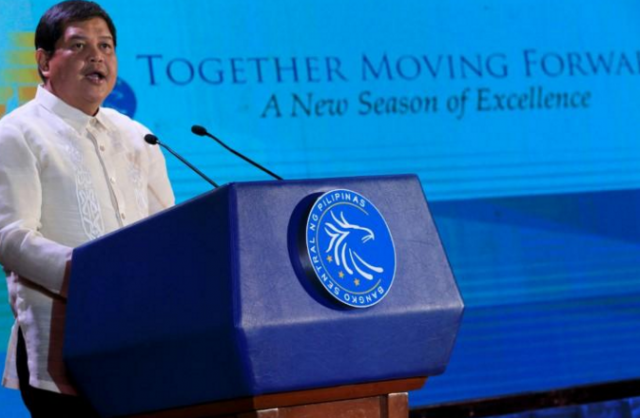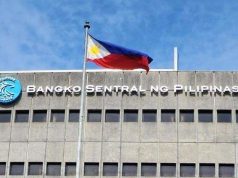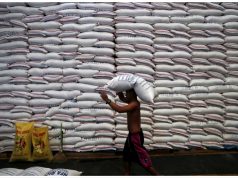
MANILA – The Bangko Sentral ng Pilipinas (BSP) is prepared to tweak its policy settings to address market volatility that could emerge from rising global interest rates, the central bank chief said, even as he noted that domestic growth and price dynamics remain sustainable so far.
BSP Governor Nestor A. Espenilla, Jr. said uncertainty over the pace of monetary policy tightening in the United States and other advanced economies would likely trigger “bouts of volatility” in financial markets worldwide, together with exchange rate movements, concerns on overheating and disruptive financial technology.
The central bank stands well-equipped to guide the economy in weathering such headwinds.
“We can rely on several anchors of stability to manage these pressing issues,” Espenilla said in a speech during the Security Bank Economic Forum 2017 Tuesday at the Makati Shangri-La hotel.
“We are ready to deploy the full array of our monetary policy toolkit in case of changes to deal with possible market volatility, as policy settings evolve and normalize in the US and other advanced economies.”
Market participants are gearing up for higher rates as they expect the US Federal Reserve to introduce another hike — its third this year — at its December policy review as part of normalization from near-zero rates following the 2008 Global Financial Crisis.
Espenilla again quelled fears of overheating, noting that growth prospects “remain bright” for the Philippines with both government and private sector investments rising.
Stable inflation, averaging 3.2% as of end-October, is likewise seen supporting stronger domestic demand as it continues to remain “manageable.” The BSP expects full-year inflation to settle at 3.2%, well within the 2-4% target band set for 2017.
“The risk of economic overheating has been raised by some analysts. We do not believe that we are there yet, and we remain very vigilant to avoid it. The current pace of credit growth is manageable,” the BSP chief said, adding that the 63.6% share of total credit relative to the economy remains the lowest in Asia.
Bank lending remains diversified and directed largely at productive activities, Espenilla said, growing by 21.1% in September.
Property prices also remain backed by fundamentals, although the BSP stands ready to deploy “targeted” policy responses should threats of a bubble arise. Latest stress tests conducted by the regulator showed the financial system is far from a crisis, Espenilla said.
On the exchange rate, Espenilla said concerns over the depreciation of the peso remain “overdone” as the currency tracks a “moderate and controlled” path versus the dollar. The peso averaged P51.3433 against the dollar last month to hit fresh 11-year-lows, hovering above P51 in the daily trading sessions.
Espenilla has said that the BSP employs tactical intervention to temper sharp exchange rate swings in daily trading, even as he noted that recent market movements reflect strong import demand, increased offshore investments held by Filipinos and debt prepayments against the backdrop of “bullish” economic growth.
The Philippine economy expanded by 6.7% in the nine months to September, well within the 6.5-7.5% growth goal set by economic managers for the entire 2017.
The Monetary Board kept key rates unchanged in its Nov. 9 meeting — this year’s seventh policy review — in the face of within-target inflation and firm domestic economic activity. Rates were kept at 3.5% for overnight lending, 3.0% for the overnight reverse repurchase rate and 2.5% for overnight deposit.
Speakers in the same forum said the Philippines has all the tools it needs to weather the impact of China’s slowing economy — the world’s second-biggest just after the United States and Asia’s largest.
“The economic reality today is that China will have a very influential say within Asia,” said Kaushik Rudra, Standard Chartered Bank managing director & global head for Rates and Credit Research.
“As China slows down, the rest of the region slows down,” he added, noting that it could dent the Philippines’ current export recovery for instance.
Hence, the need to further fortify the Philippines’ domestic economy, including by making sure that the government’s massive P8.44-trillion infrastructure plan till 2022 is realized.
“What the Philippines can do is make its own systems, own infrastructure. But also the various organizations in the country, its tools have to be stronger, aside from the banking sector,” Mr. Rudra said.
“The ingredients are all there, once you have the good mix of infrastructure and stronger stable environment that the Philippines has created for its self. Then you have a recipe for a long term sustainable platform,” he added.
“The Philippines is sustainable, it is seeing the right rate of growth.”
Finance Undersecretary Gil S. Beltran said that he expects the infrastructure plan to pick up pace starting this quarter. “For the last quarter for the year, the government can speed it up,” he said in the same forum. “The main challenge is in the implementation part. We need to prime up agencies so they would be able to spend the money.”
While gross domestic product (GDP) growth picked up to 6.9% in the third quarter — the fastest clip in four quarters — it was still slightly slower than the year-ago 7.1%.
Certain segments of the economy slowed, however.
Household consumption remained a key anchor of the economy, accounting for 55.7% of GDP in the third quarter. Growth of household spending, however, eased to 4.5% last quarter from the preceding three months’ 5.9% and the 7.2% recorded in July-September 2016. The third-quarter pace tempered year-to-date increase to 5.4% from the 7.3% logged in 2016’s comparable nine months.
Construction growth slowed to 2.8% from the second quarter’s 7.6% and from the 18.8% of 2016’s third quarter, “driven by the increase in public construction but… weighed down by the modest growth in private construction,” the Philippine Statistics Authority had reported on Nov. 16.







